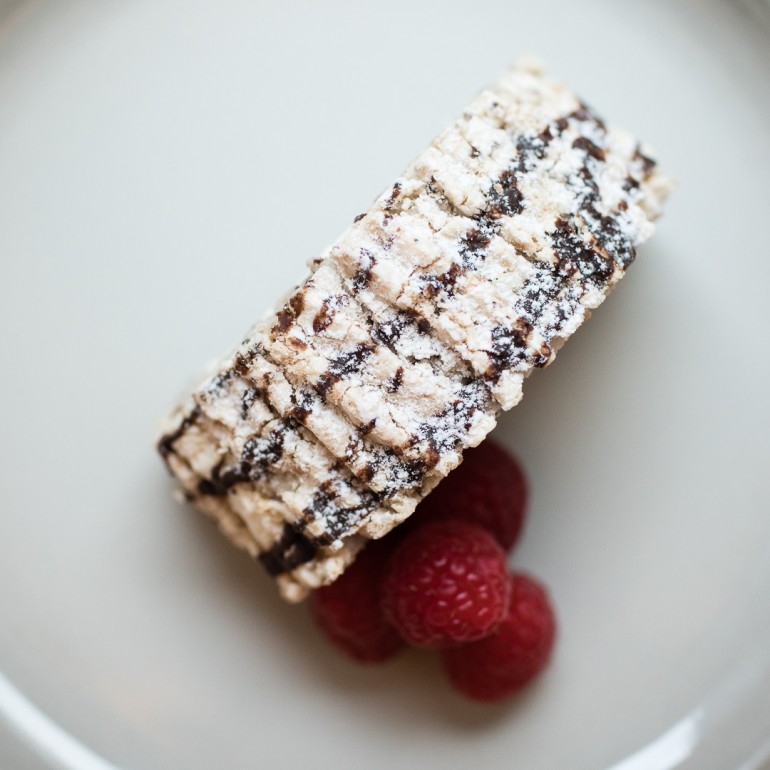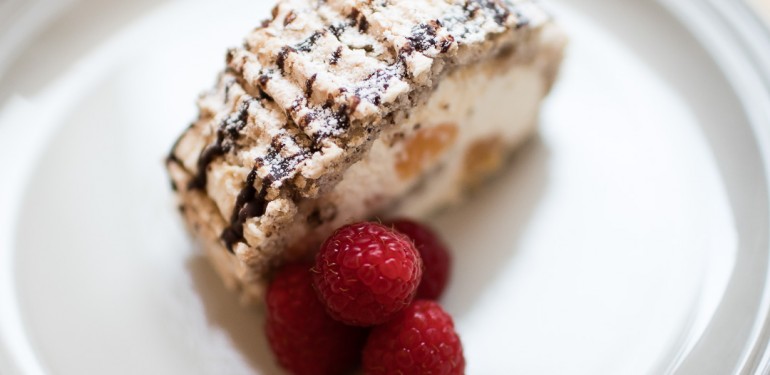Even though it’s named after the Hungarian capital, the Budapest roll has probably nothing to do with it’s namesake. It was invented in the 1900’s by the Swedish pastry chef Ingvar Strid (born 1926) and has been a staple at classic Swedish cafés ever since. In concept it’s quite similar to a type of pastries used for the afternoon coffee called rulltårtor, essentially a sponge cake with some spread, like cream and raspberries or Puncsh liqueur chocolate, rolled into a cylinder and then cut into individual pieces.
The Budapest roll is a bit fancier, being made out of hazelnut meringue and filled with cream and mandarin orange segments. It’s really not that difficult to make and can be made up to a day in advance, but can look quite professional. The soft but crunchy cover and citrus fruits provides a beautiful balance to the cream, making it a complete and very enjoyable pastry.
Budapest roll pastry
8-10 servings (60 minutes total preparation time)
- 6 egg whites
- 3 dl caster sugar
- 150 g hazelnuts
- 0.75 dl potato flour
|
The meringue bottom
- Blend the hazelnuts to a powder, preferably with a blender. Remove the outer skin if you want to, but it does add a bit of body to the meringue.
- Whisk the egg whites to stiff peaks in a bowl using a machine. Add the sugar, little by little, while continuing to whisk until all sugar is incorporated and the meringue is silky smooth and the bowl can be turned upside down.
- Add the hazelnut powder and potato flour to the meringue mixture, fold it down carefully using a spatula to keep the air in the batter.
- Place parchment paper in a baking tray. Fill a piping bag with the meringue mixture and use a ca. 11 mm star tip to draw long lines on a paper, about 1 cm thick. The lines should fill an area approximately 30 by 40 cm, with the lines running along the long dimension. It’s also possible to use a spatula to spread out the mixture, but the lines created using the piping bag technique will make the easier to roll without cracking and also prettier.
- Bake in the center of the oven at 175 degrees Centigrade (350 F) for 20 minutes, rotating the tray after ten minutes unless the oven heat is perfectly uniform. It should have some color when done.
- Let the meringue sheet cool for 1-2 minutes before flipping it over onto a new parchment paper sheet. Remove the old sheet and let it cool completely under a kitchen towel.
|
- 4 dl double cream
- 6-8 mandarin oranges
- 25 g dark chocolate
|
Finishing
- Peel the mandarins and divide into segments, removing as much of the pith as possible. Unless the mandarin oranges are very small, divide the segments using a knife. For a variation, experiment with making your own mandarin preserves or using other types of citrus fruits, for example blood oranges where the segments have been cut out.
- Whip the cream stiff but without breaking it – better to err on the softer side if unsure. Spread it out over the meringue sheet using a spatula. Spread out the mandarin segments uniformly on the cream.
- Carefully roll the meringue sheet along the short edge, keeping it intact.
- Melt the chocolate in a small bowl in a microwave or using a bain marie. Drizzle it on top of the roll. Trim the edges and either serve individual pieces or as a complete roll.
|






